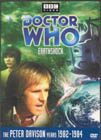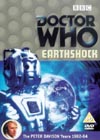DVD Extras include:
The regular characters and the guest characters all get good introductions in this story. Lt. Scott seems to be a futuristic version of the Brigadier, complete with dozens of troops. The regular cast is isolated from the guests for most of the first episode, which doesn't work too badly as the four of them have plenty to work through on their own. The grisly terror that the guests are plodding through is not very enamouring anyway, going for the fright and the gross-out too much for my tastes, although I think it would have been yet more powerful had the Doctor been involved in investigating it. The Doctor has to go through a very boring cliché distrust routine when meeting each set of guest characters, first in the cave and then later on the freighter, but luckily both of these sequences are kept relatively short (unlike some Jon Pertwee tales), and the Doctor has a more logical reason than usual for showing up at the same time as all the problems on the freighter.
"Now, you shall see our STRENGTH!"Much of the strength of this story is in the excellent story beats escalating the plot in the middle episodes. Episode two in particular allows Peter Davison's Doctor to achieve a number of victories against the Cyber forces that escalate the plot without revealing to him who his enemies are. The conflict becomes much more direct in episode three, with the Doctor still making a very good showing, but only managing to delay the inevitable. Lots of great stuff - just what you'd want from a good Doctor Who action adventure. Even where it borrows from the great cyber-adventures of the past, writer Eric Saward has a fresh take on things and leaves his own mark. A pity no one had a line about a cup of coffee though.
FIRST IMPRESSIONS - "THIS REGENERATED FORM..."Episode Two contains a brilliant sequence that defines the mythological status of the building confrontation in the story, unusually told from the villains' perspective rather than the protagonists. Having relatively little exposure to Doctor Who at the time I first saw this, the sequence of the Cybermen discovering the Doctor's TARDIS and recounting their history with him instantly elevated them from being simply one of the coolest adversaries of the moment to one of the great long-term foes of the series.This was also the moment when I realized that there had been other Doctors before Tom Baker. Deep stuff to take in. Who were these mysterious stars of the show from times past? I did come away from the sequence with some erroneous assumptions. Jon Pertwee's lack of an adventure with the Cybermen, and his subsequent exclusion from the flashback sequence, had me believing mistakenly that Tom Baker was the third Doctor, and that Peter Davison was the fourth. I also assumed that each Doctor got a run of five years, and was only allowed one Cyberman adventure each time, so it was a big deal and a serious event. Daleks? Never heard of them. Cybermen were THE big villain army on the show. And "Earthshock" was now a very big deal indeed.
Solving the Logic Codes...In the final episode, Saward has quite a task to reveal motivations for the characters that make all those previous story beats logical, while keeping the current episode interesting and setting up for his final climactic event. His end result is a fairly well-twisted pretzel that just manages to hold everything together. In terms of providing quality story beats, scene by scene, "Earthshock" is definitely Eric Saward's best original writing on the series.For me, the Cybermen have never appeared more powerful in any other Doctor Who story. More frightening maybe, but not more powerful. They do their most serious soldiering of the original show in this adventure, come dangerously close to achieving their most deadly and ambitious plans several times, and always seem to have a contingency plan and the ability to adapt to new scenarios. The Cybermen have their flaws too, but these are shown to be more flaws of character than anything physical - most notably their arrogance and over-confidence. The philosophical arguments between the Doctor and the Cyber Leader are unique highlights in the final episode, played with a nice level of tension by Peter Davison and David Banks. Of course, with this being the first Cyberman story I ever saw, I think this version of their costumes is perfect, with all others being under- or over-developed. I don't mind seeing organic jaws moving inside their helmets, although had they simply held their mouths open while talking instead of articulating each word, it would have had an even more disturbing effect, as it did in "The Tenth Planet" (story no. 29). This would have been difficult to achieve without sacrificing the great in-the-moment performances though, and in the end I think we get the better of the two deals.
Effects Supporting Story?Dave Chapman achieves some great laser effects in this story, which is no small achievement considering the amount of laser-fire action delivered. Peter Grimwade provides him with less challenging shots than other directors, I think, while giving the viewer a great dramatic ride at the same time. The "candy-stripe" visual beams for the Earth weapons deliver the kind of effect that satisfies me, while the flashing blue blobs of the cyber weapons, although somewhat inferior, still work quite well in most cases.Neither of these effects are introduced too well though. When the beams debut in the cave, it's impossible to tell who's firing what at whom.... at least not until the third effect shot - the close up of two human troopers with beams initiating from the barrels of their guns. Equally, the flashing blue blobs first seem to represent the effect of the human beam weapons bouncing harmlessly off of the Cybermen, perhaps indicating that the Cybermen have personal force-field shields or something. It is only later shots like the one where Tegan picks up a cyber-weapon that make it clear what the flashing blue circles represent. Before this episode is done, it provides us with the very best effects shot from a hand-held cyberweapon to date, when Ringway is fired at. A lucky camera move gives the flashing blue blob what it always needed - motion from barrel to target. The decision to upgrade several effects for the DVD release seems to be a case of fixing what ain't broke. For one thing, many other stories like "The Pirate Planet" (story no. 99) and "Resurrection of the Daleks" (story no. 134) need laser beam effect upgrades far, far more than "Earthshock" does, and they are sadly not being touched. Secondly, adding motion to the flashing blue cyber-blobs would improve the visual literacy of the story considerably, and is therefore more important than painting over the existing "candy-stripe" beams of the Earth forces. However, when all is said and done, the new beams do look great, very tasteful versions of the old effect that simply look more realistic, closely following the slight motions made by the actors which gave the game away before. The glow from the beams also now reflects off of the surroundings as well. Very cool. The great pity is that the flashing cyberblobs have not been touched. Arrghh! But best of all are all the CGI upgrades of the space exterior shots. Unlike those done for "The Ark in Space" (story no. 76), these shots do a vastly better job of getting the story points across, and making them as dramatic as possible. For one thing, the original version had to make do without some of the shots director Peter Grimwade had planned. The new shots pull out all the stops, and give the ending enough extra punch to make it, even for those of us who already know it by heart, as powerful now as it was decades ago when we first saw it. Very well done!
Character FrameThere is less whiney character interaction in this story than in many other Saward works. Most of it is given to Professor Kyle while she waits idly in the TARDIS, which has resulted in widespread disapproval among fans of her character, which otherwise worked very well in the cave segments of the story. Ringway gets a bit with his crewmates Berger and Captain Briggs, as does Adric in the first episode, but most of these pay off later in the story, particularly where Adric is concerned.Acting is of a high calibre by all participants in the story. It is particularly refreshing to see, in this futuristic setting containing roles normally associated with men, that there is an equal distribution of women in those roles. June Bland and Beryl Reid make the most of this, delivering an utterly believable and enjoyable captain and first officer duo. Peter Grimwade delivers the finest directing in this his last Doctor Who story as director. There is superb coverage and editing, and an infectious, engaging pace. The Cybermen have never looked better. Excellent!
Concluding action:Eric Saward delivers a number of very satisfying story beats to conclude this story, including a spellbinding confrontation between hero and villain, and a far greater & more sophisticated resolution for the fascinating temporal conundrum of the tale than he managed for a very similar one back in "The Visitation" (story no. 120).That leaves just one final beat to wrap everything up: rescuing Adric in the TARDIS, a great way to top an outstanding adventure. But here, Saward's plot fails temporal logic. Why give up on the rescue Adric in the TARDIS beat after the ship explodes? If the Doctor can get Tegan on her flight even if he wanders around Monarch's ship for a week, surely he can get Adric off HIS flight even if he has to fight the console for a month. It's not as if he and his crew saw that Adric was still on the freighter when it blew, and they have no way of knowing that the TARDIS hadn't made an additional appearance inside the freighter to pick him up. The ridiculous argument the Doctor makes against that idea doesn't occur until the regulars' opening scene in the next story, which is not a bad thing since the rumours of his death pay off later in that adventure. But discussion of the argument against completing Earthshock's final heroic beat belongs here. It's not as if Adric's rescue wasn't something they hadn't already set out to do. They just don't have as much of a good reason for giving up as the show's makers thought. Let's face it: Eric Saward and John Nathan-Turner wanted to bump Adric off, and they managed to make a great emotional roller-coaster of an adventure while doing it. And, no doubt, Adric HAS been rescued countless times in the vivid imagination and unofficial fiction of dedicated, interested fans everywhere. Adric still lives, where he is most welcome.
International Titles:Deutsch: "Erdstoß"Magyar: "Földsokk"Français: (Secousse de Terre)Русский: "Землетрясение"This story has become available on DVD and VHS video.
Comments on this article are welcome. You may contact the author from this page:
|









